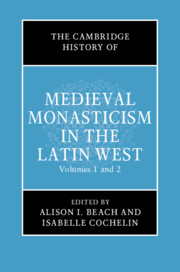Book contents
- The Cambridge History of Medieval Monasticism in the Latin WEST
- The New Cambridge History of Medieval Monasticism in the Latin West
- The Cambridge History of Medieval Monasticism in the Latin WEST
- Copyright page
- Contents
- Figures
- Contributors
- Acknowledgments
- Abbreviations
- 1 General Introduction
- Part I The Origins of Christian Monasticism to the Eighth Century
- Part II The Carolingians to the Eleventh Century
- 18 The Historiography of Central Medieval Western Monasticism
- 19 Sources for the History of Monasticism in the Central Middle Ages (c. 800–1100)
- 20 Questions of Monastic Identity in Medieval Southern Italy and Sicily (c. 500–1200)
- 21 Discerning “Reform” in Monastic Liturgy (c. 750–1050)
- 22 Monasticism, Reform, and Authority in the Carolingian Era
- 23 Carolingian Monastic Schools and Reform
- 24 Monastic Economics in the Carolingian Age
- 25 Missions on the Northern and Eastern Frontiers, c. 700–1100
- 26 Minsters and Monasticism in Anglo-Saxon England
- 27 Monastic Art and Architecture, c. 700–1100: Material and Immaterial Worlds
- 28 Monastic Daily Life (c. 750–1100): A Tight Community Shielded by an Outer Court
- 29 The Double Monastery as a Historiographical Problem (Fourth to Twelfth Century)
- 30 Interactions between Monks and the Lay Nobility (from the Carolingian Era through the Eleventh Century)
- 31 Monastic Reform from the Tenth to the Early Twelfth Century
- 32 Monastic Canon Law in the Tenth, Eleventh, and Twelfth Centuries
- 33 Eastern Influence on Western Monasticism, 850–1050
- Part III The Long Twelfth Century
- Part IV Forms of Monasticism in the Late Middle Ages
- Index
- References
20 - Questions of Monastic Identity in Medieval Southern Italy and Sicily (c. 500–1200)
from Part II - The Carolingians to the Eleventh Century
Published online by Cambridge University Press: 16 January 2020
- The Cambridge History of Medieval Monasticism in the Latin WEST
- The New Cambridge History of Medieval Monasticism in the Latin West
- The Cambridge History of Medieval Monasticism in the Latin WEST
- Copyright page
- Contents
- Figures
- Contributors
- Acknowledgments
- Abbreviations
- 1 General Introduction
- Part I The Origins of Christian Monasticism to the Eighth Century
- Part II The Carolingians to the Eleventh Century
- 18 The Historiography of Central Medieval Western Monasticism
- 19 Sources for the History of Monasticism in the Central Middle Ages (c. 800–1100)
- 20 Questions of Monastic Identity in Medieval Southern Italy and Sicily (c. 500–1200)
- 21 Discerning “Reform” in Monastic Liturgy (c. 750–1050)
- 22 Monasticism, Reform, and Authority in the Carolingian Era
- 23 Carolingian Monastic Schools and Reform
- 24 Monastic Economics in the Carolingian Age
- 25 Missions on the Northern and Eastern Frontiers, c. 700–1100
- 26 Minsters and Monasticism in Anglo-Saxon England
- 27 Monastic Art and Architecture, c. 700–1100: Material and Immaterial Worlds
- 28 Monastic Daily Life (c. 750–1100): A Tight Community Shielded by an Outer Court
- 29 The Double Monastery as a Historiographical Problem (Fourth to Twelfth Century)
- 30 Interactions between Monks and the Lay Nobility (from the Carolingian Era through the Eleventh Century)
- 31 Monastic Reform from the Tenth to the Early Twelfth Century
- 32 Monastic Canon Law in the Tenth, Eleventh, and Twelfth Centuries
- 33 Eastern Influence on Western Monasticism, 850–1050
- Part III The Long Twelfth Century
- Part IV Forms of Monasticism in the Late Middle Ages
- Index
- References
Summary
Monasticism in medieval southern Italy and Sicily has often been described using binary terms such as Greek/Latin, East/West, Basilian/Benedictine, and anchoritic/cenobitic. As a border region between the Carolingian and Byzantine empires, and an area where both Greek and Latin were used as liturgical languages, it is all too easy to view this part of Europe as a place where “Eastern” and “Western” practices met and mixed, creating a hybrid type of monasticism that can seem strange to Carolingian and Byzantine historians alike. Yet the use of categories such as Greek and Latin, and East and West causes the region to be viewed from the point of view of other traditions. It ignores indigenous practices and customs, seeing everything as an import from somewhere else. It also masks the diversity of monastic lifestyles characteristic of the region, which included wandering ascetics, cloistered monks, household religious, solitary hermits, and cave monasticism. Finally, it paints a static view of the area’s monasticism, which instead was a dynamic phenomenon owing to the constant influx of new peoples and novel religious traditions.
- Type
- Chapter
- Information
- The Cambridge History of Medieval Monasticism in the Latin West , pp. 399 - 414Publisher: Cambridge University PressPrint publication year: 2020
References
- 1
- Cited by



